Volcanic rocks are extrusive igneous rocks. There are two main groups: rocks that form from the solidification of lava flows (extrusive), and rocks that form from the compaction of solid volcanic fragments (pyroclastic). This post will cover the basics in easy-to-grasp bullet-point style that facilitates comparison between volcanic rocks. For information on eruption types, click here.
Extrusive Rocks
Basalts, andesites, and rhyolites form when lava solidifies at the earth's surface. Since at 20 °C the surface of the earth is basically freezing if you're a lava that prefers to stay at 750-1250 °C, extrusive rocks cool very rapidly. As a result, the minerals don't have time to form large crystals, which they would if they sat at depth and cooled slowly.
- Rhyolite
- Felsic (high silica content) at >70% silica
- Rocks typically light in color
- Less dense at 2.4 - 2.6 g/cm3
- Solidifies/melts at low temperatures: 750-1000 °C
- High viscosity of 106-9 Pa s (similar to silly putty) means flows form domes
- Explosive eruptions typical
- Silica bonds to itself → melt is very viscous → gas bubbles cannot escape → high volatile content → explosive eruptions when volatiles break out
- Typically occurs at continental rifts, continental hotspots, and above subduction zones
- Andesite
- Intermediate composition at 50-70% silica
- Intermediate viscosity of 103 Pa s (similar to peanut butter)
- Typically occurs above subduction zones
- Basalt
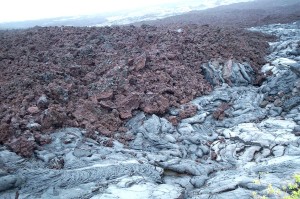
Basalt flows: a'a overriding pahoehoe. Image credit: www.colorfulfootsteps.com
- Mafic (high iron/magnesium content) at <50% silica
- Denser at 2.8 - 3.0 g/cm3
- Rocks typically dark in color
- Solidifies/melts at high temperatures: 1000-1250 °C
- Low viscosity of 101-2 Pa s (similar to ketchup) allows flows to travel long distances
- Effusive eruptions flows typical (lava seeps out)
- Pahoehoe: lava has smooth, ropey surface; typically found on gentle slopes and when lava is still hot (will turn into a'a on steep slopes or as lava cools)
- A'a: lava has angular, blocky clinker surface and base with a massive central layer (sometimes featuring columnar jointing) sandwiched in between; progresses at front in tractor-tread-like fashion, with the faster top layer rolling over to the bottom
- Typically occurs at seafloor spreading centers, oceanic hot spots, and rift valleys
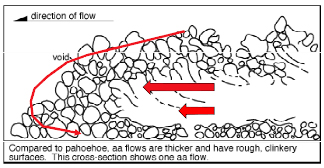
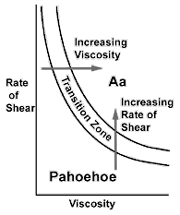
A'a flow dynamics. Pahoehoe converts into a'a as viscosity and the rate of shear (rate of deformation as the lava slides over the ground) increase. A'a advances in a tractor-tread-like fashion, with the top moving faster than the bottom, so the top rolls over at the front of the flow.
Textures:
- Glassy: smooth, glassy; indicates very rapid cooling; typical example is obsidian
- Aphanitic: fine; individual grains not visible to the naked eye; indicates rapid cooling; examples are rhyolite and basalt
- Phaneritic: individual grains visible visible to the naked eye; indicates slow cooling
- Pegmatitic: coarse; very large grains, often over 2 cm; indicates very slow cooling
- Porphyritic: contains crystals of varying sizes; formed via two-stage cooling whereby large crystals form slowly at depth and fine crystals form quickly at the surface
- Vesicular: porous, filled with cavities; develops when gas bubbles exsolve as magma rises to lower pressures (at higher pressures, the bubbles are kept in solution), and the lava then solidifies around these bubbles
- Pumice: vesicular rock of felsic composition
- Scoria: vesicular rock of mafic composition; compared to pumice, typically darker in color and denser, with thicker walls and larger vesicles
- Poikilitic: larger crystals contain small pieces of other minerals within them; typically indicates long cooling periods, allowing time for materials to diffuse into the center of the crystal
Pyroclastic Rocks
Pyroclastic rocks form from solid fragments of eruptions. Tephra is the generic term for any pyroclastic material, regardless of size or emplacement method.
Tephra fragments can be broken down by size:
- Ash: <2 mm
- Lapilli: 2-64 mm
- Bombs (round) & Blocks (angular): >64 mm
Emplacement
- Fall: ash eventually settles after being carried high above the volcano in a vertical plume
- Pyroclastic Flow: fast, concentrated (>10% solid) density current of steaming pyroclastic material; travels fastest near bottom
- Pyroclastic Surge: extremely fast (hurricane speed), dilute (<1% solid) density current of steaming pyroclastic material; concentrated density current of volcanic debris; travels fastest at top; very dangerous
Rocks
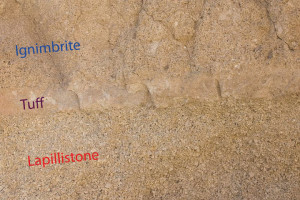
Tuff and ignimbrite. Image credit: www.sandatlas.org
- Tuff: rock made of consolidated volcanic ash, often formed by falls
- Breccia: in a volcanic context, poorly-sorted rock with angular lithic fragments embedded in an ash matrix; typically formed when an eruption causes the volcanic cone to collapse
- Ignimbrite: poorly sorted mixture of ash, lapilli, and lithic fragments deposited by a pyroclastic flow; can be layered with ash settling on top of coarser material (see figure below for more details); may contain elongated flow structures called fiamme
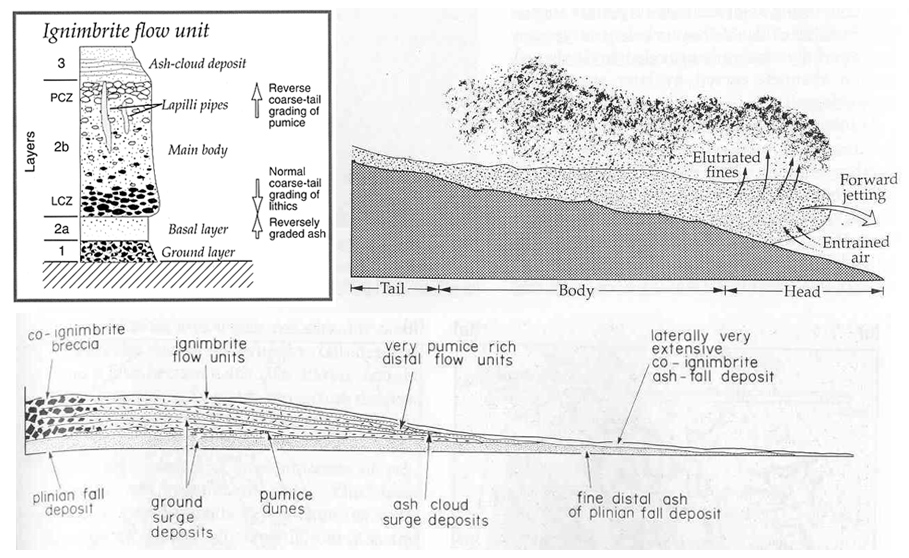
Ignimbrite deposits show vertical and lateral variation. Ash tends to be found at the top, as well as far away from the eruption. In the flow unit cross-section (upper left), white particles are pumice; black particles are lithics, and dots are ash. Layer 1 forms as heavy lithic fragments fall out at the front of the flow. Layer 2a, which shows reverse grading (larger materials on top), results from the surge kicking up material from the ground. Layer 2B, the largest layer, displays normal grading (LCZ) as heavier lithic particles settled out, followed by reverse grading as light pumice "floats" to the top. Lapilli pipes form when gas escapes, blowing out the fine gas and leaving behind just lapilli. Layer 3 develops when ash settles from secondary- or co-ignimbrite clouds (see cloud shown in upper right figure).
Epiclastic Rocks
Epiclastic rocks form when preexisting pyroclastic material is later transported and/or eroded.
- Lahar: high velocity flow of pyroclastic material mobilized by heavy rain, snow melt, flooding, or earthquakes; known to bury towns; hardens into a cement-like substance

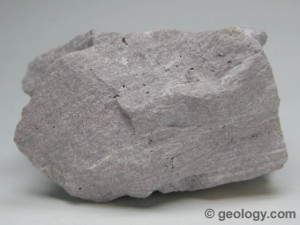
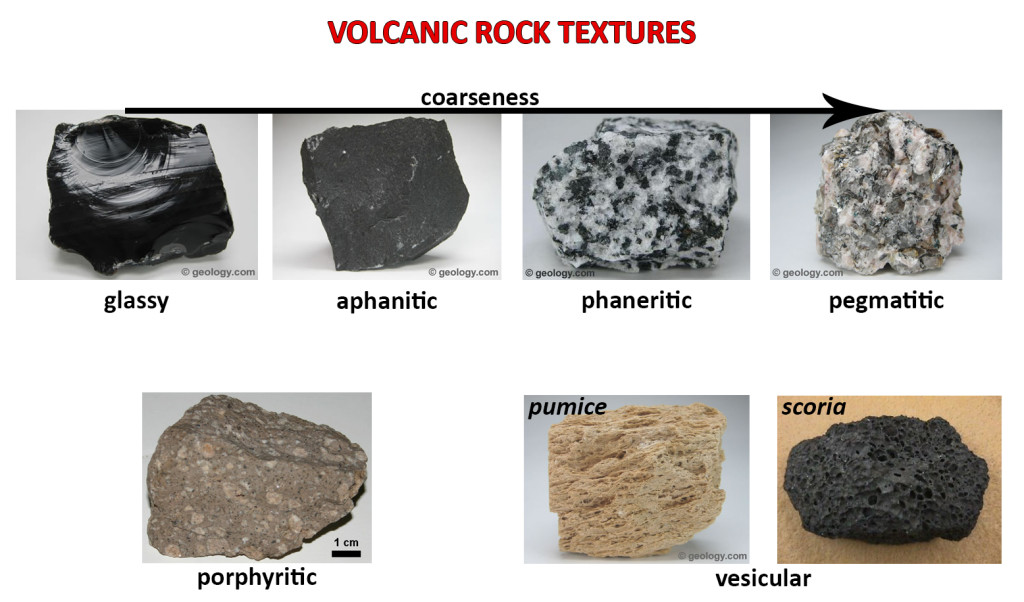
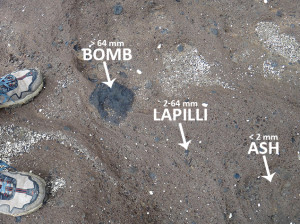
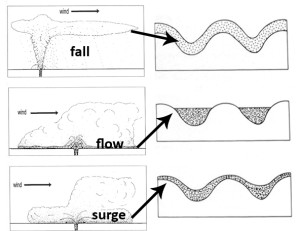

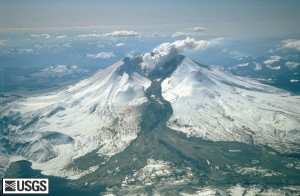
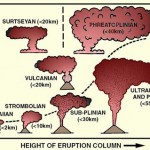
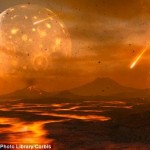
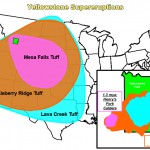
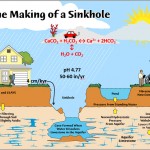
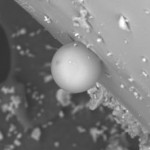
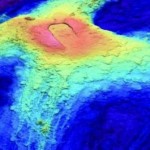
Hello! Does anyone know the original source for the "A'a flow dynamics" diagram? I'd like to include it in a paper I'm writing for class but for that I need the original source. Thank you!
Ainhoa, like a lot of the diagrams on here, that one was included in a Powerpoint given by one of my former professors, and unfortunately, the original source wasn't listed. A reverse Google image search didn't help, either. I'll look around some more, though.
Cortney Eric Johnson Thank you for looking! I found a similar image I can use in "Volcanic Textures" by McPhie et al. It was a long shot anyway, but thanks for trying!
How can we describe to differences with tephra. Thank you.
Can you rephrase your question? I don't understand.
Thanks, So Sorry because my english not fluenly. I mean how we can disthinguesh beetwen tephra and ignimbrite.
No worries! I will try to explain.
Tephra is the materials (like ash) erupted from the volcano.
Ignimbrite is the deposit, which contains tephra.
You can think of tephra as the particles, while ignimbrite is the "rock" created by tephra.
Let me know if this helps!
very helpful. Then, how to distinguish the pyroclastic breccia and ignimbrite? Thank you very much... May I have Your course materials that makes..
An ignimbrite forms from a pyroclastic flow, but breccias can form many ways (like a volcanic cone collapsing).
As far as looks, the breccia will typically have larger angular fragments (see this picture: http://www.nr.gov.nl.ca/mines&en/geosurvey/education/features/extrusive/images/breccialg.jpg). The ignimbrite usually has flow structures (see this picture: http://flexiblelearning.auckland.ac.nz/rocks_minerals/rocks/images/ignimbrite1.jpg).
Some good definitions:
http://www.encyclopedia.com/topic/Breccia.aspx#1
http://www.encyclopedia.com/doc/1O13-ignimbrite.html
Pingback: TUFF.. TUFA?.. IGNIMBRITE – Pyroclastic Deposits |